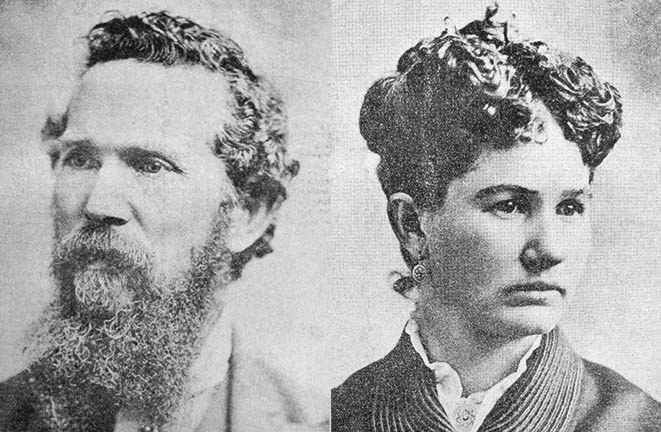Janus
The Galbraith name has a long and distinguished history in the East Kootenay and is inexorably linked with the town of Fort Steele but the family is also linked to the very wellsprings of Cranbrook. It was John Galbraith and his wife Sarah who were the first white settlers on Joseph’s Prairie and it was they, along with John’s brother Robert, who first laid claim to the land later purchased by James Baker to become present-day Cranbrook.
In 1864, John Galbraith came in search of gold along the Wild Horse Creek. It is said he traveled with the first group of miners led by Jack Fisher (for which Fisher Peak is named) but soon realized that the real money was to be found in providing miners with transportation and supplies. His brother Robert, however, states in a Herald newspaper interview of Dec.22, 1904, that by the time John arrived at the Wild Horse “he found the ground all occupied, and therefore turned his attention more in the line of strict business, such as the establishment of a ferry near where Fort Steele bridge is now built.” Either way the result was the same; John Galbraith established what would become the town of Fort Steele.
John and Robert were two of the nine children of Alexander and Rose Galbraith, all born in Ireland between the years 1826 to 1849. Of the siblings, three brothers: John, James and Robert Leslie Thomas (often referred to as R.L.T.), and two sisters: Maria, and Catherine (Kate), arrived at Fort Steele by the turn of the twentieth century.
John came first, traveling by steamer around the Cape Horn of Africa and landing in San Francisco sometime around 1858. The year 1864 found him in Walla Walla, Washington, and it was from here that he journeyed to the Wild Horse. He set up a ferry business across the Kootenay River which became known as Gailbraith’s Ferry. It was the only practical way to cross the river for the many miners making their way to the gold fields of Wild Horse Creek via the Dewdney Trail and that, combined with his general store and pack trains, soon made him a man of means.
He sent for his brothers James and Robert and also for his brothers-in-law James and Charles Clark. The Clark brothers, hailing from Liverpool and engineers by trade, married the Galbraith sisters Maria and Catherine (Kate) respectively and went on to survey much of the local district. John Galbriath met and married Sarah Larue during his time packing supplies from Walla Walla and she, too, joined the Galbraith/Clark clan in the flourishing town of Galbraith’s Ferry. Both John and his brother Robert purchased land that would later become Cranbrook and John and Sarah took up ranching there about 1867.
Wild Horse pioneer Dave Griffith, while visiting Cranbrook in 1901, spoke of the many fine residences on Baker Hill and said that the last time he was in that part of town was 15 years earlier when Mr. and Mrs. John Galbraith were the only ones there and lived in a log hut. Robert Galbraith arrived in 1870. Aside from his duties with the ferry and the general store, he served as a Member of the B.C. Legislative Assembly from 1877-1886 and served many years as the south-eastern B.C. Indian Agent.
Along with his land holdings at Joseph’s Prairie he purchased a great deal of property in and about Fort Steele. It is interesting to note that in September, 1938, M.A. Beale, a real estate and insurance agent who worked in Fort Steele before moving to Cranbrook, stated that he was present at the historic meeting between the CPR representative and Robert Galbraith, held in Tom McVittie’s parlours (Tom McVittie married Robert Galbraith’s niece, Anna) at Fort Steele.
Mr. Beale claims that the CPR demanded a share in the Fort Steele townsite which Mr. Galbraith flatly refused to surrender as he held a heavy mortgage on his soon-to-be Cranbrook property. Mr. Beale further states that, until that time, the CPR engineers strongly favoured the Fort Steele route. If that was the case then the people of Cranbrook have Robert Galbraith to thank and the people of Fort Steele have him to blame for the rise of one town and the fall of another.
In May, 1904, the government decided to move their offices from Fort Steele to Cranbrook, thus driving an unretractable spike in the coffin of the former town of Gailbraith’s Ferry. Robert Galbraith, perhaps most affected by the change due to his large property holdings in Fort Steele, took a philosophical view, saying, “Such is the fortunes of politics. Government offices are a small thing compared to the undeveloped resources and possibilities of the country.” As to the big picture he was quite correct, but as for Fort Steele it was the beginning of the end.
John and Sarah Galbraith, the first settlers of Cranbrook, sold to James Baker in 1884 and retired to Parsons Bridge near Victoria. They are both buried in the Ross Bay Cemetery. Maria Brit Clark (nee Galbraith) died at Fort Steele in 1909, as did her sister Catherine Clark in 1911. Charles Clark drowned in the Kootenany River in 1901, and his brother James died in New Westminster in 1911. Robert “Uncle Bob” Galbraith, the “Grand Old Man of the Kootenays,” at the age of 79, married Ella Fleming, 40 years his junior. Robert died at Fort Steele in 1924, and is buried along with his sisters and his wife in the cemetery there. Ella died in Cranbrook in 1966, after an extended stay in the former Bowness residence, at the time the Gardner Rest Home.
